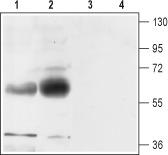Slc1a3 Rabbit Polyclonal Antibody
Other products for "Slc1a3"
Specifications
| Product Data | |
| Applications | IHC, WB |
| Recommended Dilution | WB: 1:200-1:2000; IHC: 1:100-1:3000 |
| Reactivities | Mouse, Rat |
| Host | Rabbit |
| Clonality | Polyclonal |
| Immunogen | Peptide (C)KQFKTSYEKRSFK, corresponding to amino acids 188-200 of rat EAAT1 . 2nd extracellular loop. |
| Formulation | Lyophilized. Concentration before lyophilization ~0.8mg/ml (lot dependent, please refer to CoA along with shipment for actual concentration). Buffer before lyophilization: Phosphate buffered saline (PBS), pH 7.4, 1% BSA, 0.025% NaN3. |
| Purification | Affinity purified on immobilized antigen. |
| Conjugation | Unconjugated |
| Storage | Store at -20°C as received. |
| Stability | Stable for 12 months from date of receipt. |
| Gene Name | solute carrier family 1 member 3 |
| Database Link | |
| Background | L-Glutamate (Glu) is an abundant amino acid that functions as the major excitatory neurotransmitter in the central nervous system. However, excess of Glu in the extracellular synaptic milieu leads to neuronal cell death by a process known as excitotoxicity. The extracellular levels of Glu are regulated by a family of high affinity plasma membrane transporters called excitatory amino acid transporters (EAATs) which are responsible for re-uptake of Glu into the cells. The EAAT family includes five members (EAAT1-EAAT5) that are members of the solute carrier family 1 (SLC1) of sodium-dependent transporters that also includes the neutral amino acid transporters ASCT1 and ASCT2. The Glu transporters present an unusual topology of eight transmembrane domains with two re-entrant loops and intracellular N- and C- termini. The transporter is likely assembled as a trimer where each monomer is a functional unit capable of binding the Glu substrate. The transport of Glu into the cells by the EAAT transporters is coupled to the Na+ and K+ electrochemical gradient as a driving force. Hence, the uptake of Glu is dependent on the co-transport of three Na+ and one H+ ions, and the counter transport of one K+ ion. In addition, to the well documented Glu uptake, the EAAT transporters show a Glu-independent Cl conductance. The physiological significance of the Cl current through the EAATs is currently unknown. EAAT1 as well as EAAT2, is expressed predominantly in glia cells (hence its original name: glial glutamate transporter or GLAST), while EAAT3, EAAT4 and EAAT5 are mostly expressed in neurons. As mentioned earlier, EAAT transporters represent the only (significant) mechanism for removal of glutamate from the extracellular fluid and hence are essential for the long-term maintenance of low and non-toxic concentrations of glutamate and the preservation of normal excitatory synaptic transmission. In addition, to Glu uptake the glutamate transporters provide glutamate for the synthesis of ?-Aminobutyric acid (GABA), glutathione and protein, suggesting an interactive role between EAATs and cellular metabolism. Dysregulation of EAATs activities has been implicated in several neurodegenerative disorders such as Alzheimerâ??s disease, traumatic brain injury, epilepsy and schizophrenia, suggesting that EAATs can be a useful target for the treatment of these conditions. |
| Synonyms | EA6; EAAT1; FLJ25094; GLAST; GLAST-1; GLAST1 |
| Reference Data | |
Documents
| Product Manuals |
| FAQs |
{0} Product Review(s)
0 Product Review(s)
Submit review
Be the first one to submit a review
Product Citations
*Delivery time may vary from web posted schedule. Occasional delays may occur due to unforeseen
complexities in the preparation of your product. International customers may expect an additional 1-2 weeks
in shipping.






























































































































































































































































 Germany
Germany
 Japan
Japan
 United Kingdom
United Kingdom
 China
China




